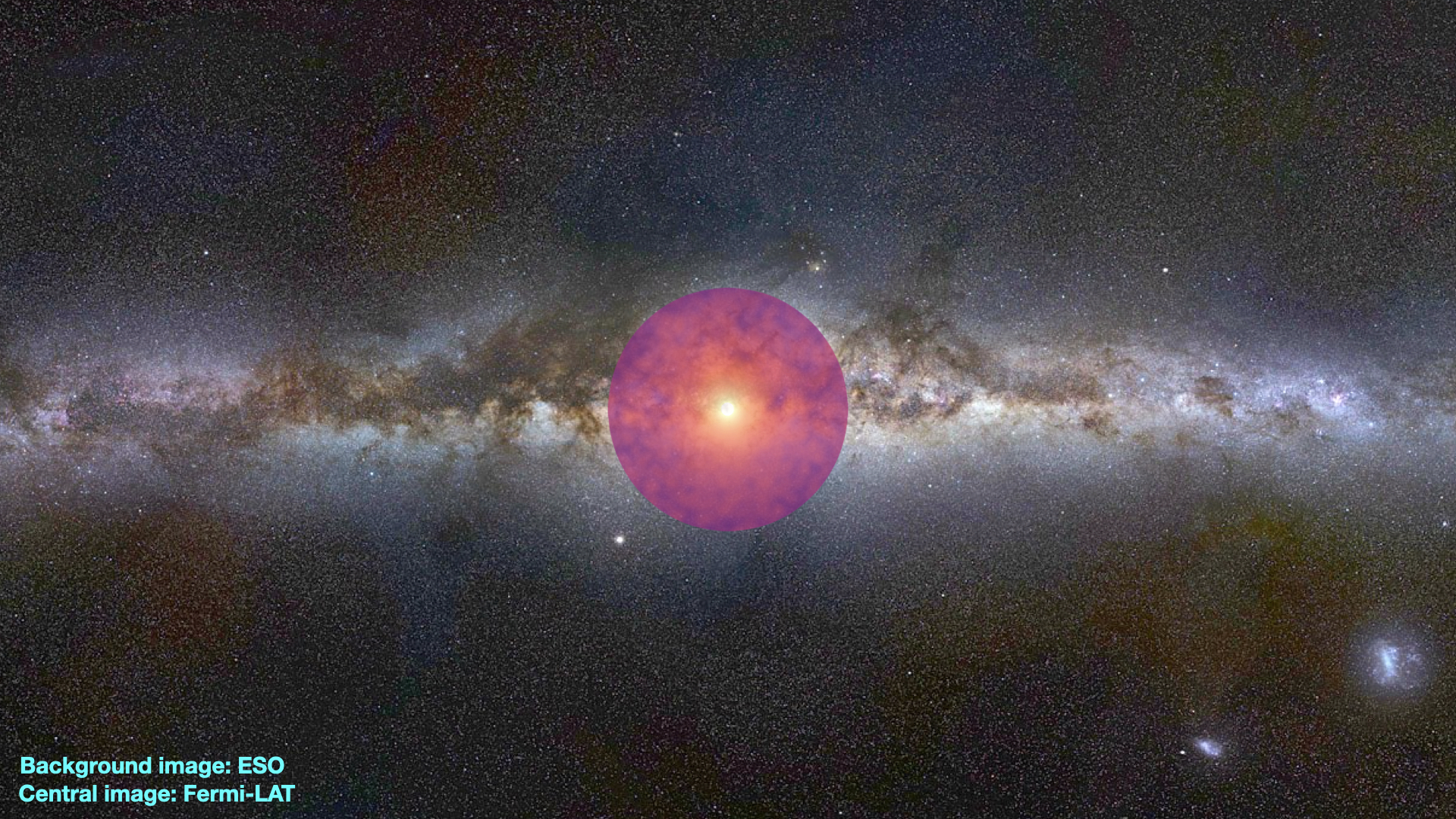Dark matter 'annihilation' may be causing the Milky Way's center to glow
Dark matter could explain the mysterious light.

A mysterious glow coming from the center of the Milky Way might be caused by annihilating dark matter — elusive matter that emits no light.
According to new research, heavy dark matter particles may be destructively colliding at the center of the galaxy, creating elementary particles, as well as gamma rays — the unexplained light seen emanating from the galactic center.
The source of this unexplained light, called the galactic center excess (GCE), has been debated by scientists ever since it was discovered in 2009. When analyzing data from NASA's Fermi Gamma-ray Space Telescope, scientists noticed a faint glow of gamma rays that couldn't be explained by known sources. In the years since, scientists have proposed a range of sources, from dark matter to more conventional sources, such as extremely fast-spinning stars called millisecond pulsars.
Related: The 11 biggest unanswered questions about dark matter
Now, a new look at over a decade's worth of data from the Fermi telescope, combined with data from an experiment on the International Space Station and observations of nearby dwarf galaxies, suggests that heavy dark matter particles at the center of the galaxy may explain the glow.
"I think the most interesting finding is that dark matter can explain the galactic center excess," while also matching observations from nearby galaxies, said study lead author Mattia di Mauro, a researcher of the Turin division of the National Institute for Nuclear Physics in Italy. "This result has never been found with a model where everything, dark matter density and particle physics model, is taken consistently."
In the new analysis, di Mauro carefully studied the excess gamma ray light to map its position, shape and energy levels. The results, published on March 22 in the journal Physical Review D, found the glow to be fairly spherical and symmetrically centered in the middle of the Milky Way.
Sign up for the Live Science daily newsletter now
Get the world’s most fascinating discoveries delivered straight to your inbox.
In a follow-up study, posted to the preprint database arXiv, di Mauro and collaborator Martin Wolfgang Winkler, a researcher at Stockholm University and The Oskar Klein Centre for Cosmoparticle Physics in Sweden, investigated what the gamma ray glow could reveal about these dark matter particles. By looking for similar gamma ray glows from dwarf spheroidal galaxies and observations from an experiment aboard the International Space Station of excess positrons, or the positively charged antimatter partners of electrons, coming from those galaxies, the researchers were able to constrain the mass and cross-section of the dark matter candidates.
The results suggest that the dark matter particles have a mass of about 60 gigaelectron volts — roughly 60 times that of a proton. When these dark matter particles collide, they annihilate into muons and antimuons, or electrons and positrons. If this hypothesis is correct, dark matter particles like these could be made and detected here on Earth with existing experiments, such as the Large Hadron Collider, and will help scientists narrow their search.
However, not all scientists are convinced by the new results. Several groups have previously ruled out GCE contributions by dark matter particles that are less massive than 400 gigaelectron volts. Other skeptics argue that the excess light is from undiscovered stars, as the light distribution maps closely to where stellar populations should be.
"They have opted for not including the [stellar distributions] in their analysis, which to me is not understandable from both a statistical and physical point of view," said Oscar Macias Ramirez, an astronomer at the University of Amsterdam who was not involved in the new research. "From the physics point of view, one should not forget that there are just too many potential gamma-ray emitters that live with stars."
If the excess light is indeed from millisecond pulsars or other stars, Macias Ramirez said, upcoming radio telescopes, such as the Square Kilometer Array in the Australian Outback, X-ray telescopes or high-energy gamma ray telescopes, such as the Cherenkov Telescope Array currently under construction in Chile's Atacama Desert, could detect these stellar populations and close the debate within the next five years.
Originally published on Live Science.

Mara Johnson-Groh is a contributing writer for Live Science. She writes about everything under the sun, and even things beyond it, for a variety of publications including Discover, Science News, Scientific American, Eos and more, and is also a science writer for NASA. Mara has a bachelor's degree in physics and Scandinavian studies from Gustavus Adolphus College in Minnesota and a master's degree in astronomy from the University of Victoria in Canada.










